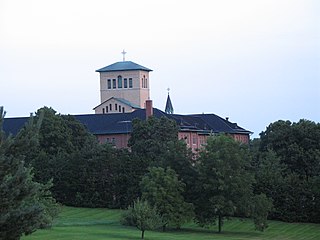
The Camaldolese Hermits of Mount Corona, commonly called Camaldolese is a monastic order of Pontifical Right for men founded by Saint Romuald. Its name is derived from the Holy Hermitage of Camaldoli, high in the mountains of central Italy, near the city of Arezzo. Its members add the nominal letters E.C.M.C. after their names to indicate their membership in the congregation. Apart from the Roman Catholic monasteries, in recent times ecumenical Christian hermitages with a Camaldolese spirituality have arisen as well.

Sacramental bread, also called Communion bread, Communion wafer, Eucharistic bread, the Lamb or simply the host, is the bread used in the Christian ritual of the Eucharist. Along with sacramental wine, it is one of two elements of the Eucharist. The bread may be either leavened or unleavened, depending on tradition.

Saint Michael's Abbey is a Benedictine abbey in Farnborough, Hampshire, England. The small community is known for its liturgy, its pipe organ, and its liturgical publishing and printing. This abbey is also known for enshrining a Pontifically crowned image of Saint Joseph.

Ligugé Abbey, formally called the Abbey of St. Martin of Ligugé, is a French Benedictine monastery in the Commune of Ligugé, located in the Department of Vienne. Dating to the 4th century, it is the site of one of the earliest monastic foundations in France. The original abbey having been destroyed during the French Revolution, the current monastic community dates from 1853, and belongs to the Solesmes Congregation.

Solesmes Abbey or St. Peter's Abbey, Solesmes is a Benedictine monastery in Solesmes, Sarthe, France, famous as the source of the restoration of Benedictine monastic life in the country under Dom Prosper Guéranger after the French Revolution. The current abbot is the Right Reverend Dom Abbot Geoffrey Kemlin, O.S.B., elected in 2022.

Prosper Louis Pascal Guéranger was a French priest and Benedictine monk, who served for nearly 40 years as the abbot of the monastery of Solesmes. Through the new Abbey of Solesmes he became the founder of the French Benedictine Congregation, which re-established Benedictine monastic life in France after it had been wiped out by the French Revolution. Guéranger was the author of The Liturgical Year, a popular commentary which covers every day of the Catholic Church's Liturgical cycles in 15 volumes. He was well regarded by Pope Pius IX, and was a proponent of the dogmas of the Immaculate Conception and of papal infallibility.

The Solesmes Congregation is an association of monasteries within the Benedictine Confederation headed by the Abbey of Solesmes.

Fontgombault Abbey, otherwise the Abbey of Notre-Dame, Fontgombault, is a Benedictine monastery of the Solesmes Congregation located in Fontgombault in the département of Indre, in the province of Berry, France. It was built in the Romanesque architectural style. The monastery, founded in 1091, was dissolved in 1791 and refounded in 1948.
St. Cecilia's Abbey, Solesmes is a Benedictine convent, founded in 1866 by Dom Prosper Guéranger, the restorer of Benedictine life in France after the destruction of the revolution. It is located in Solesmes, Sarthe, and is the women's counterpart of Solesmes Abbey.

Mère Cécile Bruyère was the first abbess of St. Cecilia's Abbey, Solesmes and a follower of Dom Prosper Guéranger in the revival of Benedictine spirituality in 19th century France.

The American-Cassinese Congregation is a Catholic association of Benedictine monasteries founded in 1855. The monasteries of the congregation follow the monastic way of life as outlined by St. Benedict of Nursia in his early 6th century Rule of Saint Benedict. The congregation is one of 19 congregations in the Benedictine Confederation and includes 25 monasteries: 19 autonomous abbeys and 6 dependent priories, located across 15 states and Puerto Rico, as well as Brazil, Canada, Colombia, Mexico, and Taiwan.

St Cecilia's Abbey, Ryde is an abbey of Benedictine nuns in the Isle of Wight, England.

Abbaye de Keur Moussa or simply Keur Mousa, near Dakar, the capital city of the Western African nation of Senegal, is a Benedictine monastery of the Solesmes Congregation. Founded in 1961 by French monks, the monastery became an abbey in 1984. As of 2000 the monastery was home to 26 monks under the leadership of Abbot Fr Philippe Champetier de Ribes Christofle. Recordings done by Sacred Spirit Music demonstrate the monks playing the kora harp and singing, and have reached Western audiences. Their music blends African rhythms and instruments with Western liturgical chant.

The Monastery Immaculate Conception is a monastery in Ferdinand, Indiana. It is home to one of the largest communities of Benedictine women in the United States. It is located approximately fifteen minutes from St. Meinrad Archabbey.

St. Paul's Abbey, Oosterhout, also Oosterhout Abbey is a former Benedictine abbey in Oosterhout, North Brabant, the Netherlands.

The Abbey of St. Maurice and St. Maurus of Clervaux, founded in 1890, is a Benedictine monastery in Clervaux, Luxembourg. It is a member of the Solesmes Congregation in the Benedictine Confederation.

The abbey of Sainte-Madeleine du Barroux also known as Le Barroux Abbey is a traditionalist Benedictine abbey located in Le Barroux, Vaucluse, France. It was founded in 1978 by Dom Gérard Calvet while the current abbot is Dom Louis-Marie de Geyer d’Orth.
















